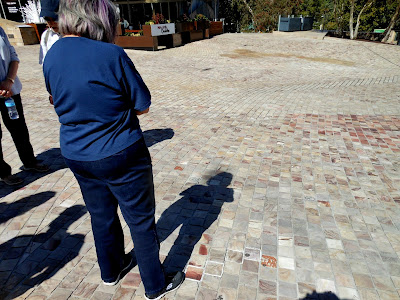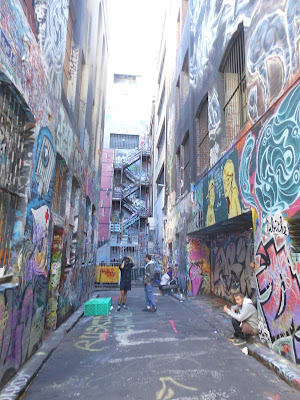Our Melbourne By Foot guide, David, is explaining the street art in one of the downtown alleyways. We thoroughly enjoyed our three-hour walk, venturing through historic streets, laneways and arcades, seeing not only this street art, but the music and café culture, architecture, sports, art projects and immigration history.
Janet and I thought we had our transportation to the downtown starting point all figured out. Well, except that we waiting for the free tram at the spot where it was going in the opposite direction. We realized it just as the correct tram pulled up across the street, and off it went before we could move to it in time. They were supposed to run every 10 minutes, so we decided we could wait for the next tram, but it didn't come and didn't come. I left a phone message for our guide that we were running late, but we'd try to make it by taxi. The taxi, of course, ran into downtown traffic, and we ended up running to find David, who was patiently waiting for us along with the other four customers. Oops.
The tour began in Federation Square, on the edge of downtown that opened recently, in 2002. It was built over the railroad tracks -- the Flinders Street Railroad Station is just across the street. The Square had many modern buildings like this one (a national TV broadcasting company).
470,000 bricks, clay-earth-colored, from Western Australia, were used to invoke an image of the Outback.
Aboriginal references.
We then walked down along the Yarra River, as David talked about the history of the country and city.
Aborigines came 40,000 to 70,000 yrs ago, and once on the continent, never explored any further or returned from where they came. They were always nomadic, never claiming any plot of land for their tribe. The English came starting in 1797, when George Bass entered the passage between the Australian mainland and Tasmania. He sailed westwards as far west as Western Port Bay (where we were the day before). In 1802, John Murray entered Port Phillip in the Lady Nelson.
We continued our walk down this river path behind (upriver, to the west).
Walking upriver led us directly into Birrarung Marr, a 20-acre park also completed in 2002. The name means "river of mists" and "river bank" in the language of the Wurundjieri people, the inhabitants at the time of European settlement. I am forgetting David's explanation about what these four spears meant, but the park had many Indigenous pieces on display.
At the end of the park, we walked across the Batman Ave. Bridge (John Batman was a founder of Melbourne). Above the tracks in the distance is Federation Square. The park is off to the left, and the old downtown is beyond on the right. We were headed there next. To our immediate left and upriver was Melbourne Park, which held their many sports arenas such as Rod Laver (tennis) Arena, Melbourne Cricket Ground, Olympic Park Oval, and most popular of all, the AAMI Rugby and Soccer Stadium (built in 2010). David took this opportunity to discuss the Melbourne (and Australian in general) obsession with rugby. The stadium has a 30,000 seating capacity (replacing the 11,000-seat venue), and it fills to capacity for every rugby match regardless of how "local" or insignificant the match might be.
Our first alley was AC/DC Lane. The street was formerly named Corporation Lane, but as a tribute to the Australian rock band, the lane was officially renamed in 2004 by a unanimous vote of the Melbourne City Council.
Lane after lane of graffiti, much of which David had stories about.
We walked all the way through The Block, a shopping arcade dating from 1893. It had dozens of fancy shops, and is considered one of the late Victorian era's finest shopping arcades. It ranks among the city's most popular tourist attractions.
The Paton Building in the right of middle (1905) is famous for its oriel color (like the bricks in Foundation Square), and the Romanesque style rather than Victorian.
This is the Gothic Bank (1887), and ANZ Banking Museum which we visited briefly.
Gothic Bank had a beautiful interior, and it was open for customers when we were there.
We walked by a roof top with travel trailers, which apparently was a creative way someone was able to offer affordable prime downtown living.
Our walk took us back to the Yarra River and over Queensbridge. The bridge ahead is Sandridge Bridge, a converted railroad bridge for pedestrians and cyclists. There are 10 of those abstract sculptures which represent the different types of immigrants who traditionally arrived by train over the bridge. There also were glass panels containing information about each country from which immigrants came to Melbourne.
Looking across the river was the Southbank Skyline.
We crossed the Southridge Bridge and returned to Foundation Square. Directly across the street was the train station, completed in 1909 and a cultural icon of Melbourne.
The station stretches down two full blocks. This was about where we hopped out of the taxi that morning to search for our tour starting spot.
Across the street was this hotel pub, where we ate our early dinner. We then took the free tram back to our Airbnb.
I walked down the street to a grocery store to purchase cookies and other goodies, and passed by this Welsh Church. I also toured an exhibit right around the corner from us, at the Royal Historical Society of Melbourne. It was titled "The Cold War Olympics", regarding the 1956 Olympic Games held during tensions among Western and Soviet nations. I was aware of the primary two events they related: the bloody hockey game between Hungary and the Soviet Union, and the marriage of Hal Connolly (U.S. gold-medalist in the hammer thrower) and Olga Fikotova (Czech gold medalist in the discus). I was well aware of the two since they lived in the South Bay and he taught at Santa Monica High School. They met at the games, and married the following year in Prague before 40,000 people who cheered them on for getting past all the red tape set up to prevent their marriage.
That evening, we talked a long time with our host about his planned trip to the U.S., and California in particular. We made several recommendations for him. I looked up, on my computer, tours that he could take
Our flight to Auckland was early the next morning, so we packed and got as ready as we could. It was a nice day seeing Melbourne up close.





























No comments:
Post a Comment